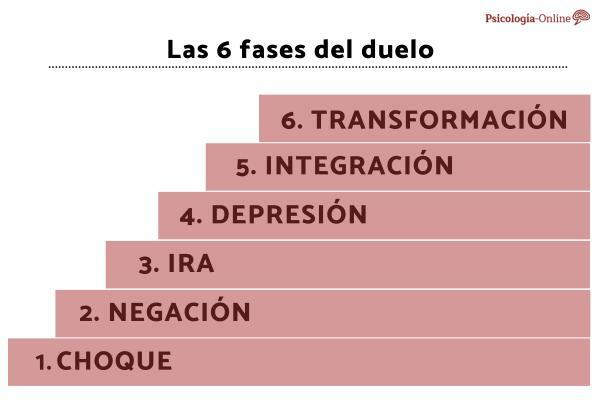
Grief is the adaptation process necessary after a loss. A loss can be of many types, although it is commonly talked about the loss of a loved one, it can also be a loss to employment level, such as a job change, a loss of health, due to a medical diagnosis, a relationship breakdown or migration.
Any loss implies a great change, and adaptation to this change is grief, which has a variable duration and consists of several stages. In this Psychology-Online article, we will see the different phases of grief in psychology, based on scientific evidence and the theories of authors such as Elisabeth Kübler-Ross and John Bowlby.
Index
- What is grief in psychology
- The phases of mourning according to authors
- Stun and shock
- Avoidance and denial
- Go to
- Depression
- Connection and integration
- Growth and transformation
What is grief in psychology.
Grief is experienced as something complicated and pain is experienced because we are social beings and we create bonds with others. In addition, we have security and protection needs that are met in a familiar environment and stagger to great changes. Any change implies an effort to adapt to new circumstances that is not usually easy to carry out.
Grief is not a disorder or a disease, however, it is a painful process that can be complicated. Some of the risk factors for a complicated bereavement are sudden deaths and unauthorized bereavement, such as abortions and perinatal deaths or suicides.
In the vast majority of cases, grief is a normal process with no complications. It can even be transformative for personal development.
The phases of mourning according to authors.
According to Elisabeth Külber-Ross[1], the 5 stages of grief are as follows:
- Denial
- Go to
- Negotiation
- Depression
- Acceptance
On the other hand, Colin Murray Parkes[2] proposes the following 4 stages of grief:
- Insensitivity
- I long
- Disorganization
- Reorganized behavior
Another model on the soil phases is that of J. William Worden[3]:
- Accept reality
- Work on emotions and experience pain
- Adapting to the environment without the loved one
- Reposition and remember the loved one
On the other hand, Robert A. Neimeyer[4] proposes the following stages of grief:
- Recognize the reality of loss
- Open up to pain
- Review our world of meanings
- Rebuild the relationship with what has been lost
- Reinvent ourselves
Finally, there is a model that integrates the aforementioned perspectives, the Integrative-relational model of Alba Payás Puigarnau[5]:
- Shock
- Avoidance-denial
- Connection-integration
- Growth-transformation
Next, we will see the main phases of the duel adapting the different proposals of the authors.
Stun and shock.
The first phase of grief is characterized by feelings of daze, confusion, or even dissociation, which function as a protection mechanism against high impact that is the loss. At this point, the loss is neither recognized nor accepted.
In this first stage, it is important that the bereaved begin to connect with the pain and express it, since otherwise, it could lead to a complicated grief.
Avoidance and denial.
This stage of mourning is very characteristic. We can see how the person denies reality, avoids connecting with pain, and represses emotional expression. At this point in the grief, it is usual to fill the agenda to not have free time, to say to be fine and not want help.
The main objective of this phase of grief is to gradually become aware of the denial and gradually reduce the avoidance strategies, to gradually recognize the loss and manage the pain. The essential task is to recognize the loss, that is, to accept and understand death. Otherwise, a complicated absent or avoidant grief can be triggered, which leads to hyperactivity and self-destructive behaviors.
Go to.
This phase of the duel is characterized by the following emotional reactions: anger, envy, hostility... Being able to perform self-destructive behaviors. In this phase, it is necessary to express emotions by managing them well, avoiding dysfunctional behaviors.
Depression.
At this point in the grief, the grieving person feels a deep pain and sadness. In this phase of grief, lack of activity, lack of grooming guidelines or habitual routines, such as changes in meals and general disorganization, can be observed. It is possible that the mourner in this phase of mourning identifies with hopelessness, apathy ...
At this point, it is important to feel the emotions, without being carried away by them. Little by little, the bereaved person must reorganize her life, adopting new routines, doing rewarding activities and leading a healthy lifestyle.
Connection and integration.
At this point in the grieving process, the grieving person begins to connect with the reality of loss and the emotions it generates: sadness, guilt, pain... The behaviors that we can observe in this phase are talking about loss and recourse, visiting places associated with the loved one ...
The main tasks in this phase of grief are: reacting to the separation, that is, feeling, identifying and accepting emotional reactions; as well as remembering what was lost and reviewing it realistically. If this part of the duel is not elaborated, a chronic duel could be complicated and unchained.
Growth and transformation.
In this phase of mourning, the reorganization of the inner world of the suffering person and of his / her life, even using the loss for personal growth.
This article is merely informative, in Psychology-Online we do not have the power to make a diagnosis or recommend a treatment. We invite you to go to a psychologist to treat your particular case.
If you want to read more articles similar to The phases of mourning, we recommend that you enter our category of Emotions.
References
- Kübler-Ross, E. (2017). On death and the dying: Relief from psychological suffering, Debolsillo.
- Parkes, C. M. (1972). Accuracy of predictions of survival in later stages of cancer. British Medical Journal, 2 (5804), 29-31.
- Worden, J. (1997). The four tasks of mourning. Worden JW: Grief Treatment, Counseling and Therapy. Barcelona: Paidós.
- Neimeyer, R. (2007). Learn from loss. A guide to coping with grief. Chapter 4: The activity of the duel. Chapter 7: Rebuilding Meaning and the Experience of Loss.
- Payás, A. (2010). The tasks of mourning. Grief psychotherapy from an Integrative-Relational model. Editorial Paidós. Spain.


